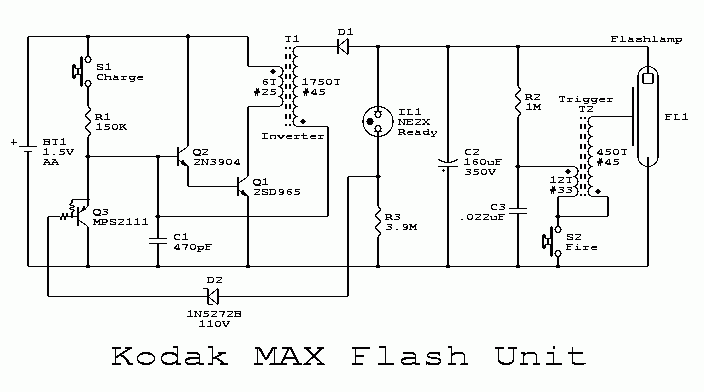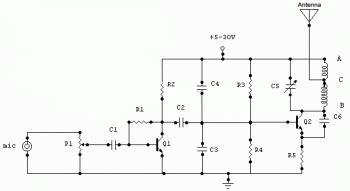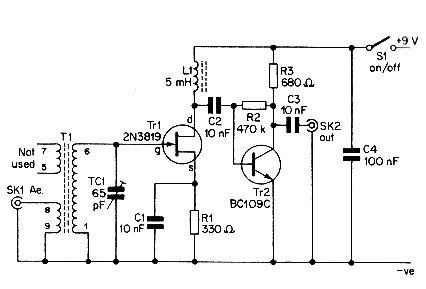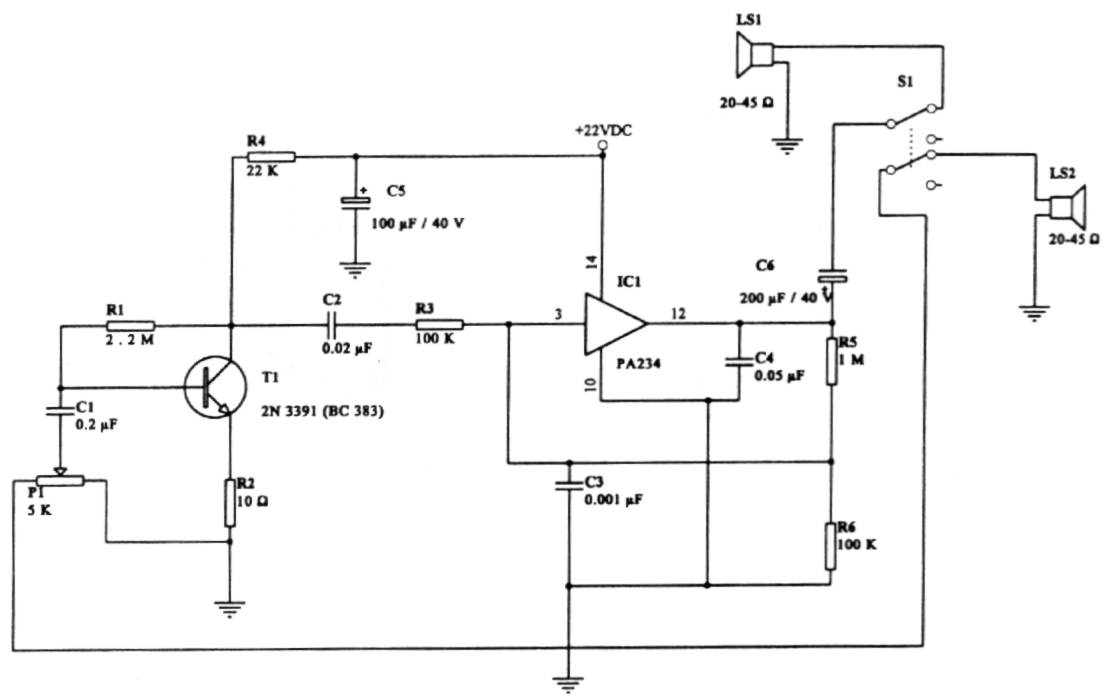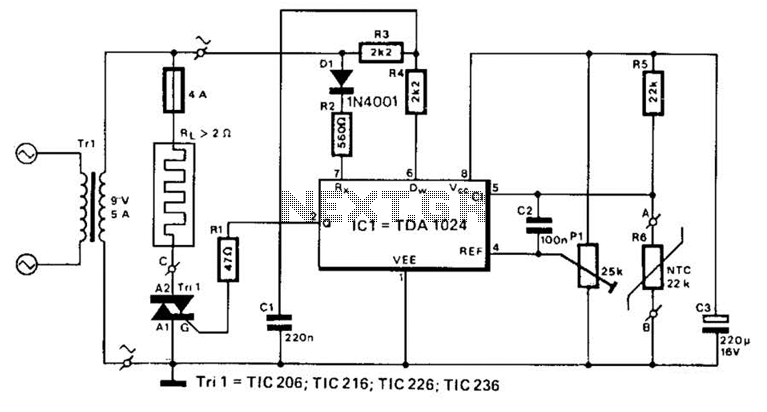
Electronic thermometer circuit
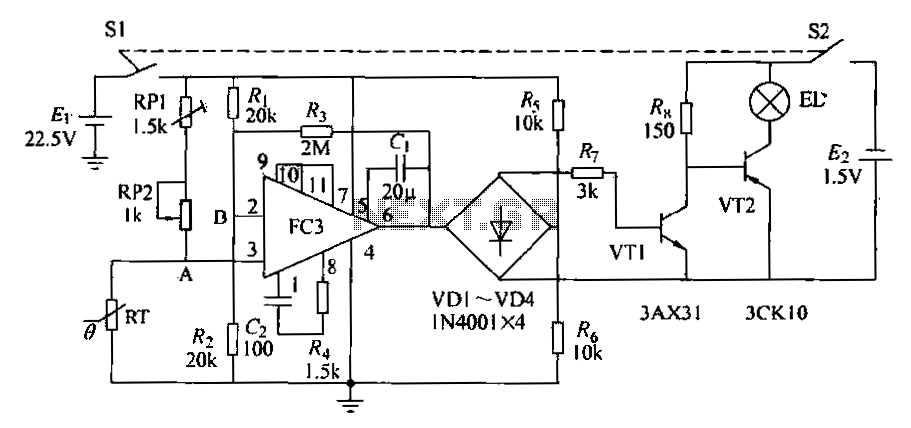
The circuit diagram illustrates an electronic thermometer. RT represents the thermistor, while A denotes an integrated operational amplifier. The diodes VD1 to VD4 provide a unidirectional output signal. The transistors VT1 and VT2 form a switching circuit. When the resistance of the thermistor RT changes in response to the temperature of the measured object, a differential signal is generated between points A and B. This signal is amplified by A and then rectified by VD1 to VD4. The rectified signal is applied to the base of VT1, causing it to conduct, while VT2 remains off, resulting in the small light bulb not illuminating. Adjusting the resistance of RP2 allows for the elimination of the difference signal between A and B; this causes both VT1 and VT2 to conduct, turning on the small light bulb. If a potentiometer is marked on the temperature scale, the bulb will illuminate when the measured temperature is reached. The thermistor used is a negative temperature coefficient model RRG3J22, which has a resistance of 10 kΩ at 20°C; a glass envelope is preferred for better performance (a positive temperature coefficient thermistor may also be used). The operational amplifier used is of lower quality, with leakage current for VT1 and VT2 being less than 100 µA, and gain greater than 30. The small light bulb operates at a voltage of 2.5V or less. The circuit is powered by a 5V laminated battery, typically comprising four batteries.
The electronic thermometer circuit operates by utilizing a thermistor, which is a temperature-sensitive resistor that changes its resistance based on temperature variations. The negative temperature coefficient (NTC) thermistor model RRG3J22 is specifically chosen for its sensitivity to temperature changes, making it ideal for precise temperature measurements. The integrated operational amplifier (A) amplifies the differential voltage signal generated between points A and B, which is crucial for accurate temperature detection.
The rectification process is accomplished through the arrangement of diodes (VD1 to VD4), which ensure that the output signal is unidirectional. This is necessary for controlling the subsequent switching action of the transistors (VT1 and VT2). The switching mechanism allows for the indication of temperature through a small light bulb. When the thermistor's resistance aligns with the set reference point, indicated by the adjustment of RP2, the circuit transitions from a non-conductive state (light bulb off) to a conductive state (light bulb on), signaling that the desired temperature has been reached.
The use of a potentiometer for scaling temperature readings allows for flexibility in calibration, enabling the circuit to be tailored for specific temperature ranges. The operational amplifier's performance is critical; therefore, its gain and leakage current specifications must be adhered to, ensuring reliable operation. The power supply, a 5V laminated battery, provides sufficient voltage for the circuit components, maintaining functionality over extended use. This design combines simplicity with effectiveness, making it a practical solution for temperature measurement applications.Electronic thermometers as shown in the circuit. RT is the thermistor, A is an integrated operational amplifier. VD1 ~ VD4 composition marked by the scribe mushroom flow channe l, unidirectional output signal. VT1, VT2 etc. switching circuit. When the thermistor RT temperature resistance with the measured object changes to a certain degree of resistance when, A, B two points there is a difference signal output of this signal by the A amplification, after VD1 ~ VD4 rectified, added to the base of VT1 pole, VT1 conduction, VT2 off, a small light bulb mouth. Does not shine this time. Changing the electrical resistance of RP2 locator, so that A, B no difference between the two output signals, the deadline VT1, VT2 conduction, small bulbs on the light.
If the mark on the temperature scale potentiometer, then the lights when reading out the measured object temperature. Rr metal shell negative temperature coefficient thermistor, model RRG3J22,20 when the resistance is lOkfl, if the glass envelope is more desirable (positive temperature coefficient thermistor may be).
A use of substandard goods gain operational amplifier. VT1, VT2 leakage current is less than lOOtjLA, Lu is greater than 30. A small light bulb voltage of 2.5V or less. Ei with ZZ. 5v Instrument laminated battery, easy bureau section 4 battery.
The electronic thermometer circuit operates by utilizing a thermistor, which is a temperature-sensitive resistor that changes its resistance based on temperature variations. The negative temperature coefficient (NTC) thermistor model RRG3J22 is specifically chosen for its sensitivity to temperature changes, making it ideal for precise temperature measurements. The integrated operational amplifier (A) amplifies the differential voltage signal generated between points A and B, which is crucial for accurate temperature detection.
The rectification process is accomplished through the arrangement of diodes (VD1 to VD4), which ensure that the output signal is unidirectional. This is necessary for controlling the subsequent switching action of the transistors (VT1 and VT2). The switching mechanism allows for the indication of temperature through a small light bulb. When the thermistor's resistance aligns with the set reference point, indicated by the adjustment of RP2, the circuit transitions from a non-conductive state (light bulb off) to a conductive state (light bulb on), signaling that the desired temperature has been reached.
The use of a potentiometer for scaling temperature readings allows for flexibility in calibration, enabling the circuit to be tailored for specific temperature ranges. The operational amplifier's performance is critical; therefore, its gain and leakage current specifications must be adhered to, ensuring reliable operation. The power supply, a 5V laminated battery, provides sufficient voltage for the circuit components, maintaining functionality over extended use. This design combines simplicity with effectiveness, making it a practical solution for temperature measurement applications.Electronic thermometers as shown in the circuit. RT is the thermistor, A is an integrated operational amplifier. VD1 ~ VD4 composition marked by the scribe mushroom flow channe l, unidirectional output signal. VT1, VT2 etc. switching circuit. When the thermistor RT temperature resistance with the measured object changes to a certain degree of resistance when, A, B two points there is a difference signal output of this signal by the A amplification, after VD1 ~ VD4 rectified, added to the base of VT1 pole, VT1 conduction, VT2 off, a small light bulb mouth. Does not shine this time. Changing the electrical resistance of RP2 locator, so that A, B no difference between the two output signals, the deadline VT1, VT2 conduction, small bulbs on the light.
If the mark on the temperature scale potentiometer, then the lights when reading out the measured object temperature. Rr metal shell negative temperature coefficient thermistor, model RRG3J22,20 when the resistance is lOkfl, if the glass envelope is more desirable (positive temperature coefficient thermistor may be).
A use of substandard goods gain operational amplifier. VT1, VT2 leakage current is less than lOOtjLA, Lu is greater than 30. A small light bulb voltage of 2.5V or less. Ei with ZZ. 5v Instrument laminated battery, easy bureau section 4 battery.

